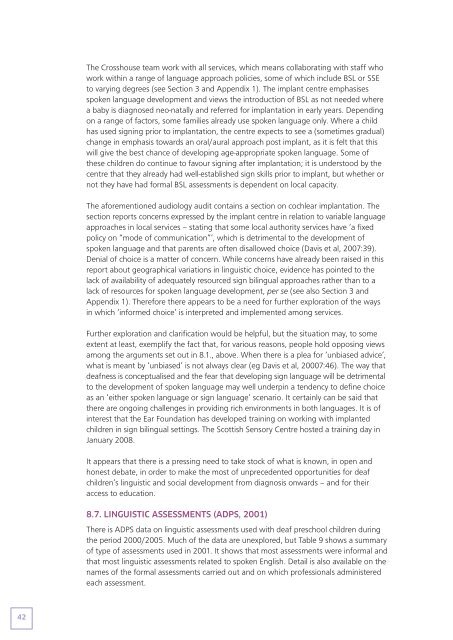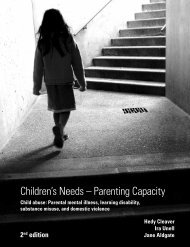British Sign Language and Linguistic Access Working Group ...
British Sign Language and Linguistic Access Working Group ...
British Sign Language and Linguistic Access Working Group ...
Create successful ePaper yourself
Turn your PDF publications into a flip-book with our unique Google optimized e-Paper software.
The Crosshouse team work with all services, which means collaborating with staff whowork within a range of language approach policies, some of which include BSL or SSEto varying degrees (see Section 3 <strong>and</strong> Appendix 1). The implant centre emphasisesspoken language development <strong>and</strong> views the introduction of BSL as not needed wherea baby is diagnosed neo-natally <strong>and</strong> referred for implantation in early years. Dependingon a range of factors, some families already use spoken language only. Where a childhas used signing prior to implantation, the centre expects to see a (sometimes gradual)change in emphasis towards an oral/aural approach post implant, as it is felt that thiswill give the best chance of developing age-appropriate spoken language. Some ofthese children do continue to favour signing after implantation; it is understood by thecentre that they already had well-established sign skills prior to implant, but whether ornot they have had formal BSL assessments is dependent on local capacity.The aforementioned audiology audit contains a section on cochlear implantation. Thesection reports concerns expressed by the implant centre in relation to variable languageapproaches in local services – stating that some local authority services have ‘a fixedpolicy on “mode of communication”’, which is detrimental to the development ofspoken language <strong>and</strong> that parents are often disallowed choice (Davis et al, 2007:39).Denial of choice is a matter of concern. While concerns have already been raised in thisreport about geographical variations in linguistic choice, evidence has pointed to thelack of availability of adequately resourced sign bilingual approaches rather than to alack of resources for spoken language development, per se (see also Section 3 <strong>and</strong>Appendix 1). Therefore there appears to be a need for further exploration of the waysin which ‘informed choice’ is interpreted <strong>and</strong> implemented among services.Further exploration <strong>and</strong> clarification would be helpful, but the situation may, to someextent at least, exemplify the fact that, for various reasons, people hold opposing viewsamong the arguments set out in 8.1., above. When there is a plea for ‘unbiased advice’,what is meant by ‘unbiased’ is not always clear (eg Davis et al, 20007:46). The way thatdeafness is conceptualised <strong>and</strong> the fear that developing sign language will be detrimentalto the development of spoken language may well underpin a tendency to define choiceas an ‘either spoken language or sign language’ scenario. It certainly can be said thatthere are ongoing challenges in providing rich environments in both languages. It is ofinterest that the Ear Foundation has developed training on working with implantedchildren in sign bilingual settings. The Scottish Sensory Centre hosted a training day inJanuary 2008.It appears that there is a pressing need to take stock of what is known, in open <strong>and</strong>honest debate, in order to make the most of unprecedented opportunities for deafchildren’s linguistic <strong>and</strong> social development from diagnosis onwards – <strong>and</strong> for theiraccess to education.8.7. LINGUISTIC ASSESSMENTS (ADPS, 2001)There is ADPS data on linguistic assessments used with deaf preschool children duringthe period 2000/2005. Much of the data are unexplored, but Table 9 shows a summaryof type of assessments used in 2001. It shows that most assessments were informal <strong>and</strong>that most linguistic assessments related to spoken English. Detail is also available on thenames of the formal assessments carried out <strong>and</strong> on which professionals administeredeach assessment.42
















